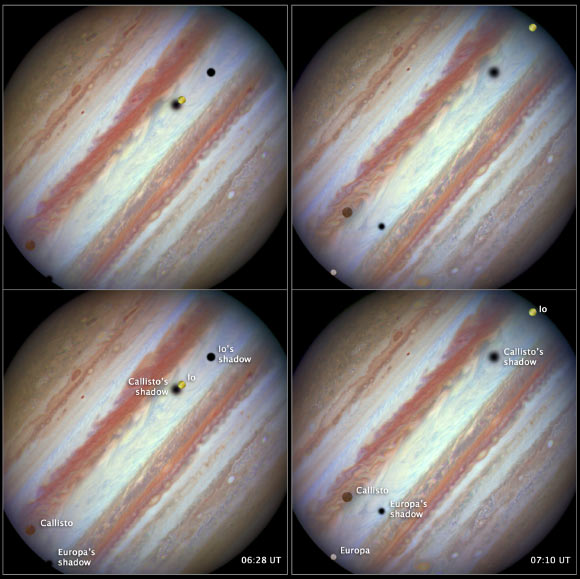The Wide Field Camera 3 on NASA’s Hubble Space Telescope has captured a rare look at three of Galilean moons – Io, Callisto, and Europa – zipping across the banded face of Jupiter.

The Hubble image on the left (unlabeled at top left, labeled at bottom left) shows the beginning of the event, which took place on January 24, 2015. From left to right the moons Callisto and Io are above Jupiter’s cloud tops. The shadows from Europa (not seen in the image), Callisto, and Io are strung out from left to right. Near the end of the event, approximately 42 minutes later (right-side image), Europa has entered the frame at lower left. Slower-moving Callisto is above and to the right of Europa. Fastest-moving Io is approaching the eastern limb of the planet; its shadow is no longer visible on Jupiter. Europa’s shadow is toward the left side of the image, and Callisto’s shadow to the right. Missing from the sequence is the moon Ganymede, which was outside Hubble’s field of view and too far from Jupiter in angular separation to be considered part of the conjunction. The moons in these photos have distinctive colors. The ancient, cratered surface of Callisto is brownish; the smooth icy surface of Europa is yellow-white; and the volcanic, sulfur-dioxide surface of Io is orange. The apparent fuzziness of some of the shadows depends on the moons’ distances from Jupiter. The farther away a moon is from the planet, the softer the shadow, because the shadow is more spread out across the disk. The images were taken with Hubble’s Wide Field Camera 3 in visible light. Image credit: NASA / ESA / Hubble Heritage Team / STScI / AURA.
Named after Galileo Galilei who discovered them in January 1610, the Galilean moons are the four largest moons of Jupiter: Io, Europa, Ganymede, and Callisto.
The four moons complete orbits around the gas giant ranging 2 to 17 days in duration.
They can commonly be seen crossing the face of Jupiter and casting shadows onto its layers of cloud.
However, seeing three moons transiting the face of Jupiter at the same time is rare, occurring only once or twice a decade.
Missing from the sequence, taken by Hubble on January 24, 2015, is the moon Ganymede that was too far from Jupiter in angular separation to be part of the conjunction.
The image on the left shows the Hubble observation at the beginning of the event.
On the left is the moon Callisto and on the right, Io.
The shadows from Callisto, Io and Europa are strung out from left to right.
Europa itself cannot be seen in the image.
The image on the right shows the end of the event, just over 40 minutes later. Europa has entered the frame at lower left with slower-moving Callisto above and to the right of it.
Meanwhile Io – which orbits significantly closer to Jupiter and so moves much more quickly – is approaching the eastern limb of the planet.
Whilst Callisto’s shadow seems hardly to have moved, Io’s has set over the planet’s eastern edge and Europa’s has risen further in the west.
Missing from this sequence is the Galilean moon Ganymede which was outside Hubble’s field of view.
The Galilean moons have very distinctive colors. The smooth icy surface of Europa is yellow-white, the volcanic sulfur surface of Io is orange and the surface of Callisto, which is one of the oldest and most cratered surfaces known in the Solar System, is a brownish color.







